Development of A Multi-Spectral Pyrometry Sensor for High-Speed Transient Surface-Temperature Measurements in Combustion-Relevant Harsh Environments
Abstract
1. Introduction
2. Measurement Principle: Multi-Spectral Radiation Thermometry
- : Emitted radiation intensity (W/m2-μm) at wavelength λ (μm) and temperature T (K)
- : Emissivity at wavelength λ
- c1: 2π h co2 = 3.742 E8 W-μm4/m2
- c2: h co/kB = 14,388 μm-K,
2.1. LLS MRT: Linear Least-Squares Method
2.2. NLLS MRT: Constrained Non-Linear Least-Squares Optimization Method
3. Emissivity Model Selection
3.1. Linear vs. Non-Linear MRT
4. Wavelength Regions Selection
4.1. Wavelength Selection Rules of Thumb
4.2. Wavelength Selection to Avoid Measurement Interference from Combustion Gases
5. Multi-Start Method to Find Global Optimum
6. Instrument Setup and Calibration
6.1. Optical Probe and Instrument Hardware
6.2. Instrument Calibration
6.3. MRT Analysis
7. Bench Validation of the Instrument and the MRT Analysis
8. Conclusions
Supplementary Materials
Author Contributions
Funding
Institutional Review Board Statement
Informed Consent Statement
Data Availability Statement
Acknowledgments
Conflicts of Interest
Notice
References
- Kundu, P.; Scarcelli, R.; Som, S.; Ickes, A.; Wang, Y.; Kiedaisch, J.; Rajkumar, M. Modeling Heat Loss through Pistons and Effect of Thermal Boundary Coatings in Diesel Engine Simulations Using a Conjugate Heat Transfer Model; No. 2016-01-2235; SAE Technical Paper; SAE International: Warrendale, PA, USA, 2016. [Google Scholar]
- Margot, X.; Quintero, P.; Gomez-Soriano, J.; Escalona, J. Implementation of 1D–3D integrated model for thermal prediction in internal combustion engines. Appl. Therm. Eng. 2021, 194, 117034. [Google Scholar] [CrossRef]
- Broatch, A.; Olmeda, P.; Margot, X.; Escalona, J. New approach to study the heat transfer in internal combustion engines by 3D modelling. Int. J. Therm. Sci. 2019, 138, 405–415. [Google Scholar] [CrossRef]
- Iqbal, O.; Arora, K.; Sanka, M. Thermal map of an IC engine via conjugate heat transfer: Validation and test data correlation. SAE Int. J. Engines 2014, 7, 366–374. [Google Scholar] [CrossRef]
- Manara, J.; Zipf, M.; Stark, T.; Arduini, M.; Ebert, H.-P.; Tutschke, A.; Hallam, A.; Hanspal, J.; Langley, M.; Hodge, D. Technology, Long wavelength infrared radiation thermometry for non-contact temperature measurements in gas turbines. Infrared Phys. Technol. 2017, 80, 120–130. [Google Scholar] [CrossRef]
- Arulprakasajothi, M.; Rupesh, P.L. Surface temperature measurement of gas turbine combustor using temperature-indicating paint. Int. J. Ambient. Energy 2022, 43, 2324–2327. [Google Scholar] [CrossRef]
- Kerr, C.; Ivey, P.J. Optical pyrometry for gas turbine aeroengines. Sens. Rev. 2004, 24, 378–386. [Google Scholar] [CrossRef]
- Jatana, G.; Geckler, S.; Koeberlein, D.; Partridge, W. Design and development of a probe-based multiplexed multi-species absorption spectroscopy sensor for characterizing transient gas-parameter distributions in the intake systems of IC engines. Sens. Actuators B Chem. 2017, 240, 1197–1204. [Google Scholar] [CrossRef]
- Jatana, G.; Kocher, L.; Moon, S.-M.; Popuri, S.; Augustin, K.; Tao, F.; Wu, Y.; Booth, R.; Geckler, S.; Koeberlein, D. Mapping of exhaust gas recirculation and combustion-residual backflow in the intake ports of a heavy-duty diesel engine using a multiplexed multi-species absorption spectroscopy sensor. Int. J. Engine Res. 2018, 19, 542–552. [Google Scholar] [CrossRef]
- Jatana, G.S.; Perfetto, A.K.; Geckler, S.C.; Partridge, W.P. Absorption spectroscopy based high-speed oxygen concentration measurements at elevated gas temperatures. Sens. Actuators B Chem. 2019, 293, 173–182. [Google Scholar] [CrossRef]
- Soid, S.; Zainal, Z. Spray and combustion characterization for internal combustion engines using optical measuring techniques—A review. Energy 2011, 36, 724–741. [Google Scholar] [CrossRef]
- Sementa, P.; Vaglieco, B.M.; Catapano, F. Thermodynamic and optical characterizations of a high performance GDI engine operating in homogeneous and stratified charge mixture conditions fueled with gasoline and bio-ethanol. Fuel 2012, 96, 204–219. [Google Scholar] [CrossRef]
- Drake, M.; Haworth, D. Advanced gasoline engine development using optical diagnostics and numerical modeling. Proc. Combust. Inst. 2007, 31, 99–124. [Google Scholar] [CrossRef]
- Mansoor, A.; Allemand, C.; Eagar, T. Noncontact temperature measurement. II. Least squares based techniques. Rev. Sci. Instrum. 1991, 62, 403–409. [Google Scholar]
- Araújo, A. Multi-spectral pyrometry—A review. Meas. Sci. Technol. 2017, 28, 082002. [Google Scholar] [CrossRef]
- Zhao, H.; Ladommatos, N. Optical diagnostics for soot and temperature measurement in diesel engines. Prog. Energy Combust. Sci. 1998, 24, 221–255. [Google Scholar] [CrossRef]
- Wen, C.-D.; Mudawar, I. Experimental investigation of emissivity of aluminum alloys and temperature determination using multispectral radiation thermometry (MRT) algorithms. J. Mater. Eng. Perform. 2002, 11, 551–562. [Google Scholar] [CrossRef]
- Luan, Y.; Mei, D.; Shi, S. Light-field multi-spectral radiation thermometry. Opt. Lett. 2021, 46, 9–12. [Google Scholar] [CrossRef]
- Marr, M.A.; Wallace, J.S.; Chandra, S.; Pershin, L.; Mostaghimi, J. A fast response thermocouple for internal combustion engine surface temperature measurements. Exp. Therm. Fluid Sci. 2010, 34, 183–189. [Google Scholar] [CrossRef]
- Assanis, D.N.; Badillo, E. Evaluation of alternative thermocouple designs for transient heat transfer measurements in metal and ceramic engines. SAE Trans. 1989, 98, 1036–1051. [Google Scholar]
- Chang, J.; Filipi, Z.; Assanis, D.; Kuo, T.; Najt, P.; Rask, R. Characterizing the thermal sensitivity of a gasoline homogeneous charge compression ignition engine with measurements of instantaneous wall temperature and heat flux. Int. J. Engine Res. 2005, 6, 289–310. [Google Scholar] [CrossRef]
- Kerr, C.; Ivey, P. An overview of the measurement errors associated with gas turbine aeroengine pyrometer systems. Meas. Sci. Technol. 2002, 13, 873. [Google Scholar] [CrossRef]
- Husberg, T.; Gjirja, S.; Denbratt, I.; Omrane, A.; Aldén, M.; Engström, J. Piston Temperature Measurement by Use of Thermographic Phosphors and Thermocouples in a Heavy-Duty Diesel Engine Run under Partly Premixed Conditions; No. 2005-01-1646; SAE Technical Paper; SAE International: Warrendale, PA, USA, 2005. [Google Scholar]
- Kashdan, J.T.; Bruneaux, G. Laser-Induced Phosphorescence Measurements of Combustion Chamber Surface Temperature on a Single-Cylinder Diesel Engine; No. 2011-01-2049; SAE Technical Paper; SAE International: Warrendale, PA, USA, 2011. [Google Scholar]
- Fuhrmann, N.; Litterscheid, C.; Ding, C.-P.; Brübach, J.; Albert, B.; Dreizler, A. Cylinder head temperature determination using high-speed phosphor thermometry in a fired internal combustion engine. Appl. Phys. B 2014, 116, 293–303. [Google Scholar] [CrossRef]
- Fuhrmann, N.; Schneider, M.; Ding, C.; Brübach, J.; Dreizler, A. Two-dimensional surface temperature diagnostics in a full-metal engine using thermographic phosphors. Meas. Sci. Technol. 2013, 24, 095203. [Google Scholar] [CrossRef]
- Heyes, A.; Seefeldt, S.; Feist, J. Two-colour phosphor thermometry for surface temperature measurement. Opt. Laser Technol. 2006, 38, 257–265. [Google Scholar] [CrossRef]
- Stojkovic, B.D.; Fansler, T.D.; Drake, M.C.; Sick, V. High-speed imaging of OH* and soot temperature and concentration in a stratified-charge direct-injection gasoline engine. Proc. Combust. Inst. 2005, 30, 2657–2665. [Google Scholar] [CrossRef]
- Matsui, Y.; Kamimoto, T.; Matsuoka, S. A study on the application of the two–color method to the measurement of flame temperature and soot concentration in diesel engines. SAE Trans. 1980, 89, 3043–3055. [Google Scholar]
- Matsui, Y.; Kamimoto, T.; Matsuoka, S. A study on the time and space resolved measurement of flame temperature and soot concentration in a DI diesel engine by the two-color method. SAE Trans. 1979, 88, 1808–1822. [Google Scholar]
- Musculus, M.P.; Singh, S.; Reitz, R.D. Gradient effects on two-color soot optical pyrometry in a heavy-duty DI diesel engine. Combust. Flame 2008, 153, 216–227. [Google Scholar] [CrossRef]
- Howell, J.R.; Siegel, R. Thermal radiation heat transfer. Volume 3-Radiation transfer with absorbing, emitting, and scattering media. 1971. Available online: https://ntrs.nasa.gov/api/citations/19710021465/downloads/19710021465.pdf (accessed on 13 December 2022).
- Müller, B.; Renz, U. Development of a fast fiber-optic two-color pyrometer for the temperature measurement of surfaces with varying emissivities. Rev. Sci. Instrum. 2001, 72, 3366–3374. [Google Scholar] [CrossRef]
- Marx, D.T.; Policandriotes, T.; Zhang, S.; Scott, J.; Dinwiddie, R.B.; Wang, H. Measurement of interfacial temperatures during testing of a subscale aircraft brake. J. Phys. D Appl. Phys. 2001, 34, 976. [Google Scholar] [CrossRef]
- Hijazi, A.; Sachidanandan, S.; Singh, R.; Madhavan, V. A calibrated dual-wavelength infrared thermometry approach with non-greybody compensation for machining temperature measurements. Meas. Sci. Technol. 2011, 22, 025106. [Google Scholar] [CrossRef]
- Kong, J.; Shih, A.J. Infrared Thermometry for Diesel Exhaust Aftertreatment Temperature Measurement; No. 2004-01-0962; SAE Technical Paper; SAE International: Warrendale, PA, USA, 2002. [Google Scholar]
- Ciatti, S.A.; Blobaum, E.L.; Foster, D.E. Determination of Diesel Injector Nozzle Characteristics Using Two-Color Optical Pyrometry; No. 2002-01-0746; SAE Technical Paper; SAE International: Warrendale, PA, USA, 2002. [Google Scholar]
- Wen, C.-D. Study of steel emissivity characteristics and application of multispectral radiation thermometry (MRT). J. Mater. Eng. Perform. 2011, 20, 289–297. [Google Scholar] [CrossRef]
- Weng, K.-H.; Wen, C.-D. Effect of oxidation on aluminum alloys temperature prediction using multispectral radiation thermometry. Int. J. Heat Mass Transf. 2011, 54, 4834–4843. [Google Scholar] [CrossRef]
- Orlande, H.R.; Fudym, O.; Maillet, D.; Cotta, R.M. Thermal Measurements and Inverse Techniques; CRC Press: Boca Raton, FL, USA, 2011; Volume 977. [Google Scholar]
- Splitter, D.; Reitz, R.; Hanson, R. High efficiency, low emissions RCCI combustion by use of a fuel additive. SAE Int. J. Fuels Lubr. 2010, 3, 742–756. [Google Scholar] [CrossRef]
- Rein, K.D.; Sanders, S.T.; Lowry, S.R.; Jiang, E.Y.; Workman, J.J. In-cylinder Fourier-transform infrared spectroscopy. Meas. Sci. Technol. 2008, 19, 043001. [Google Scholar] [CrossRef]
- Geiser, F.; Wytrykus, F.; Spicher, U. Combustion Control with the Optical Fibre Fitted Production Spark Plug; SAE transactions (1998); SAE International: Warrendale, PA, USA, 1998; pp. 118–130. [Google Scholar]
- Longdill, S.; Raine, R.; Blanchard, G.; Wright, W.J.S.T. Investigation into air-fuel ratio measurement of a high performance two-stroke engine by an optical method. J. Engines 2002, 111, 1231–1243. [Google Scholar]
- Chou, T.; Patterson, D.J. In-cylinder measurement of mixture maldistribution in a L-head engine. Combust. Flame 1995, 101, 45–57. [Google Scholar] [CrossRef]
- Withrow, L.; Rassweiler, G.M. Spectroscopic studies of engine combustion. Ind. Eng. Chem. 1931, 23, 769–776. [Google Scholar] [CrossRef]
- Withrow, L.; Rassweiler, G.M. Studying engine combustion by physical methods a review. J. Appl. Phys. 1938, 9, 362–372. [Google Scholar] [CrossRef]
- Bleekrode, R.; Nieuwpoort, W.C. Absorption and Emission Measurements of C2 and CH Electronic Bands in Low-Pressure Oxyacetylene Flames. J. Chem. Phys. 1965, 43, 3680–3687. [Google Scholar] [CrossRef]
- Frank, J.H.; Barlow, R.S.; Lundquist, C. Radiation and nitric oxide formation in turbulent non-premixed jet flames. Proc. Combust. Inst. 2000, 28, 447–454. [Google Scholar] [CrossRef]
- Brookes, S.; Moss, J.J.C. Flame, Measurements of soot production and thermal radiation from confined turbulent jet diffusion flames of methane. Combust. Flame 1999, 116, 49–61. [Google Scholar] [CrossRef]
- Gordon, I.E.; Rothman, L.S.; Hill, C.; Kochanov, R.V.; Tan, Y.; Bernath, P.F.; Birk, M.; Boudon, V.; Campargue, A.; Chance, K.V.; et al. The HITRAN2016 molecular spectroscopic database. J. Quant. Spectrosc. Radiat. Transf. 2017, 203 (Suppl. C), 3–69. [Google Scholar] [CrossRef]
- Tu, W.; Mayne, R. Studies of multi-start clustering for global optimization. Int. J. Numer. Methods Eng. 2002, 53, 2239–2252. [Google Scholar] [CrossRef]
- Ugray, Z.; Lasdon, L.; Plummer, J.; Glover, F.; Kelly, J.; Martí, R. Scatter search and local NLP solvers: A multistart framework for global optimization. Inf. J. Comput. 2007, 19, 328–340. [Google Scholar] [CrossRef]
- Rinnooy Kan, A.; Timmer, G. Stochastic global optimization methods part I: Clustering methods. Math. Program. 1987, 39, 27–56. [Google Scholar] [CrossRef]
- Dixon, L.C.W. The global optimization problem: An introduction. Towar. Glob. Optim. 1978, 2, 1–15. [Google Scholar]
- Elwakeil, O.A.; Arora, J.S. Two algorithms for global optimization of general NLP problems. Int. J. Numer. Methods Eng. 1996, 39, 3305–3325. [Google Scholar] [CrossRef]
- Sepulveda, A.; Epstein, L.J. The repulsion algorithm, a new multistart method for global optimization. Struct. Optim. 1996, 11, 145–152. [Google Scholar] [CrossRef]
- Splitter, D.; Colomer, V.B.; Neupane, S.; Chuahy, F.D.F.; Partridge, W.P. In Situ Laser Induced Florescence Measurements of Fuel Dilution from Low Load to Stochastic Pre Ignition Prone Conditions; No. 2021-01-0489; SAE Technical Paper: 2005; SAE International: Warrendale, PA, USA.
- Partridge, W.P.; Choi, J.-S.; Connatser, P.R.M.; Currier, N.; Geckler, S.; Yezerets, A.; Kamasamudram, K. Cummins/ORNL-FEERC CRADA: NOx Control & Measurement Technology for Heavy-Duty Diesel Engines. 2011 DOE Vehicle Technologies Program Annual Merit Review, Arlington, Virginia, May 12, 2011. Available online: https://www.energy.gov/sites/default/files/2014/03/f11/ace032_partridge_2011_o.pdf (accessed on 13 December 2022).
- Yoo, J.; Prikhodko, V.; Parks, J.E.; Perfetto, A.; Geckler, S.; Partridge, W.P. Fast spatially resolved exhaust gas recirculation (EGR) distribution measurements in an internal combustion engine using absorption spectroscopy. Appl. Spectrosc. 2015, 69, 1047–1058. [Google Scholar] [CrossRef]

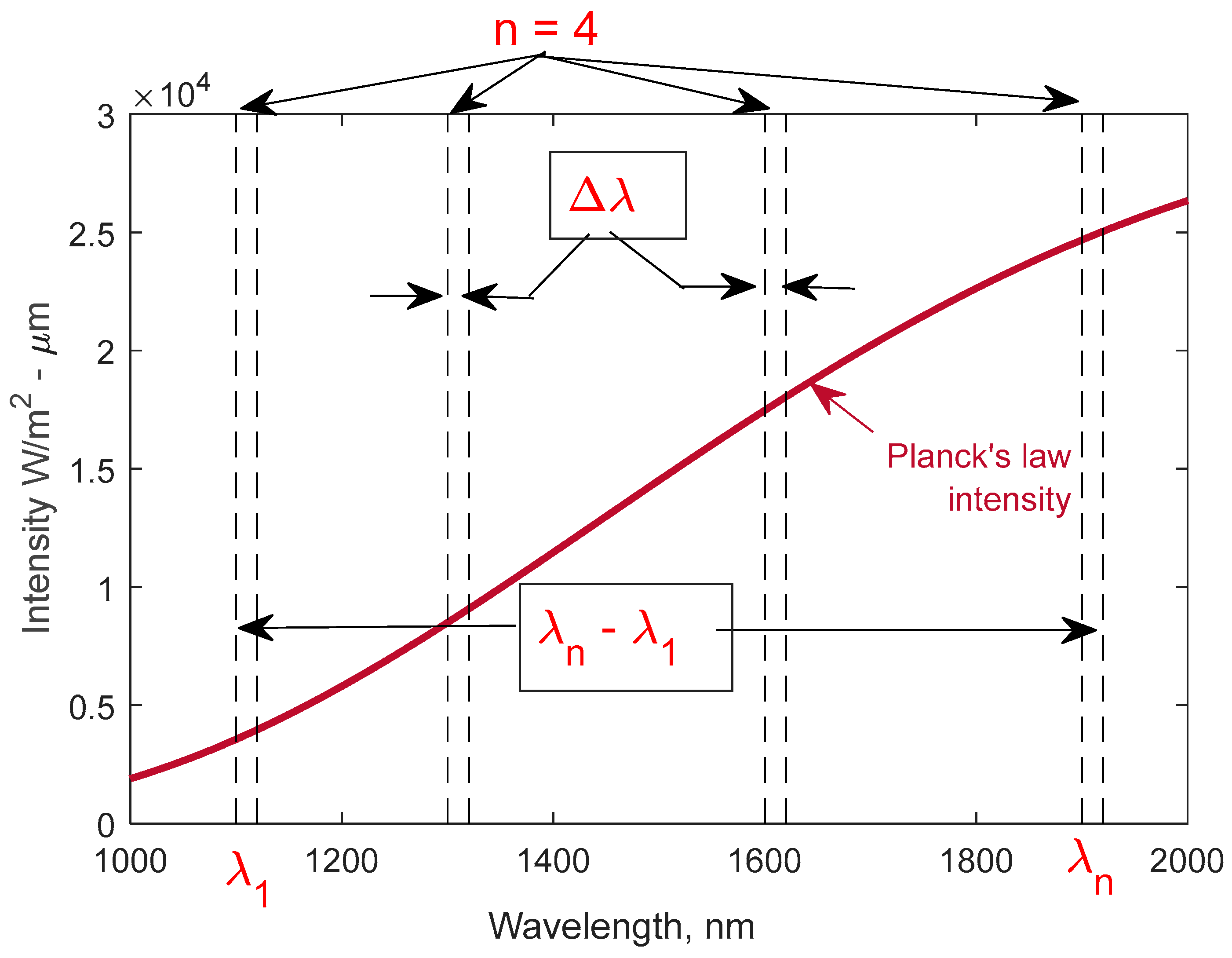

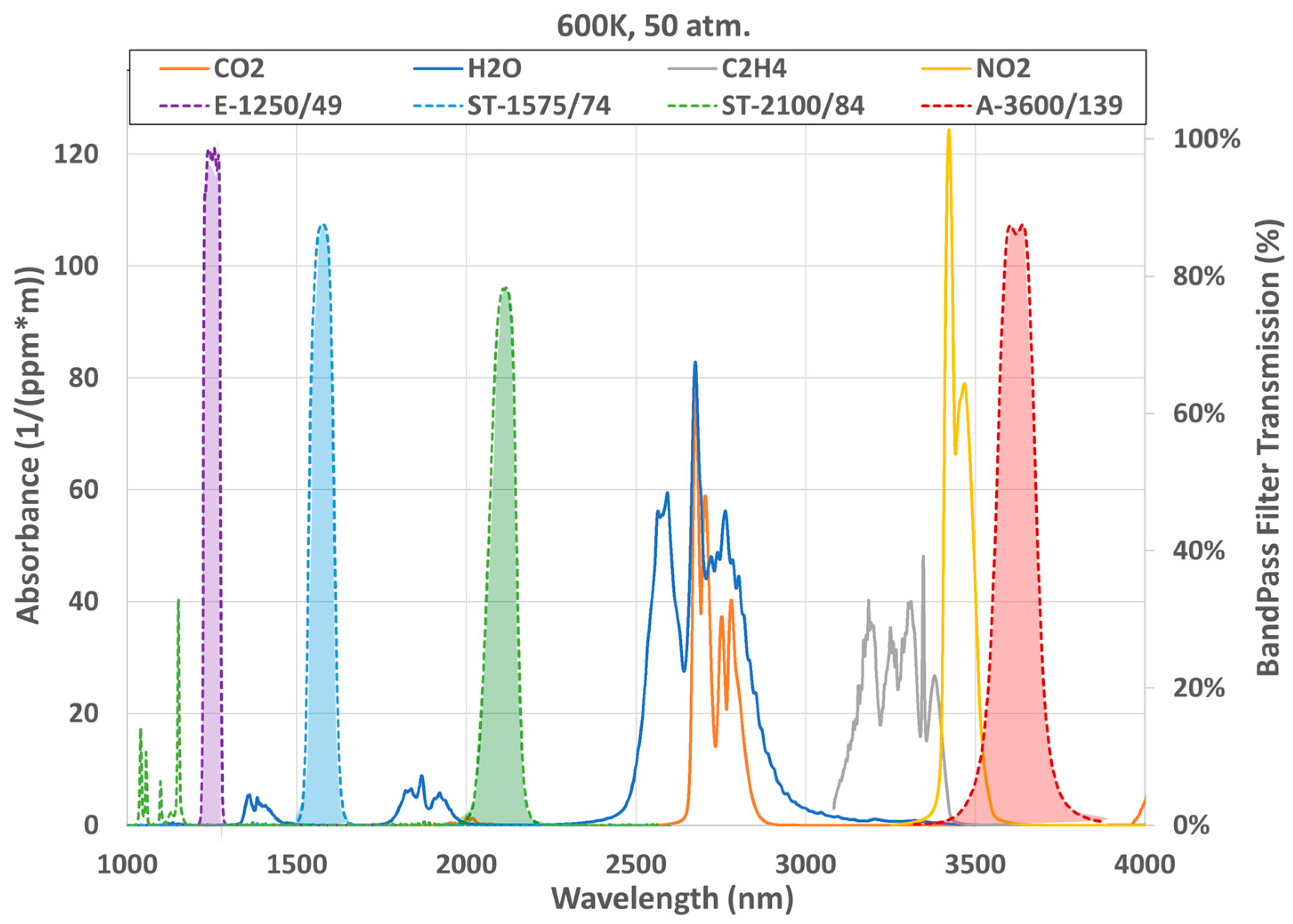

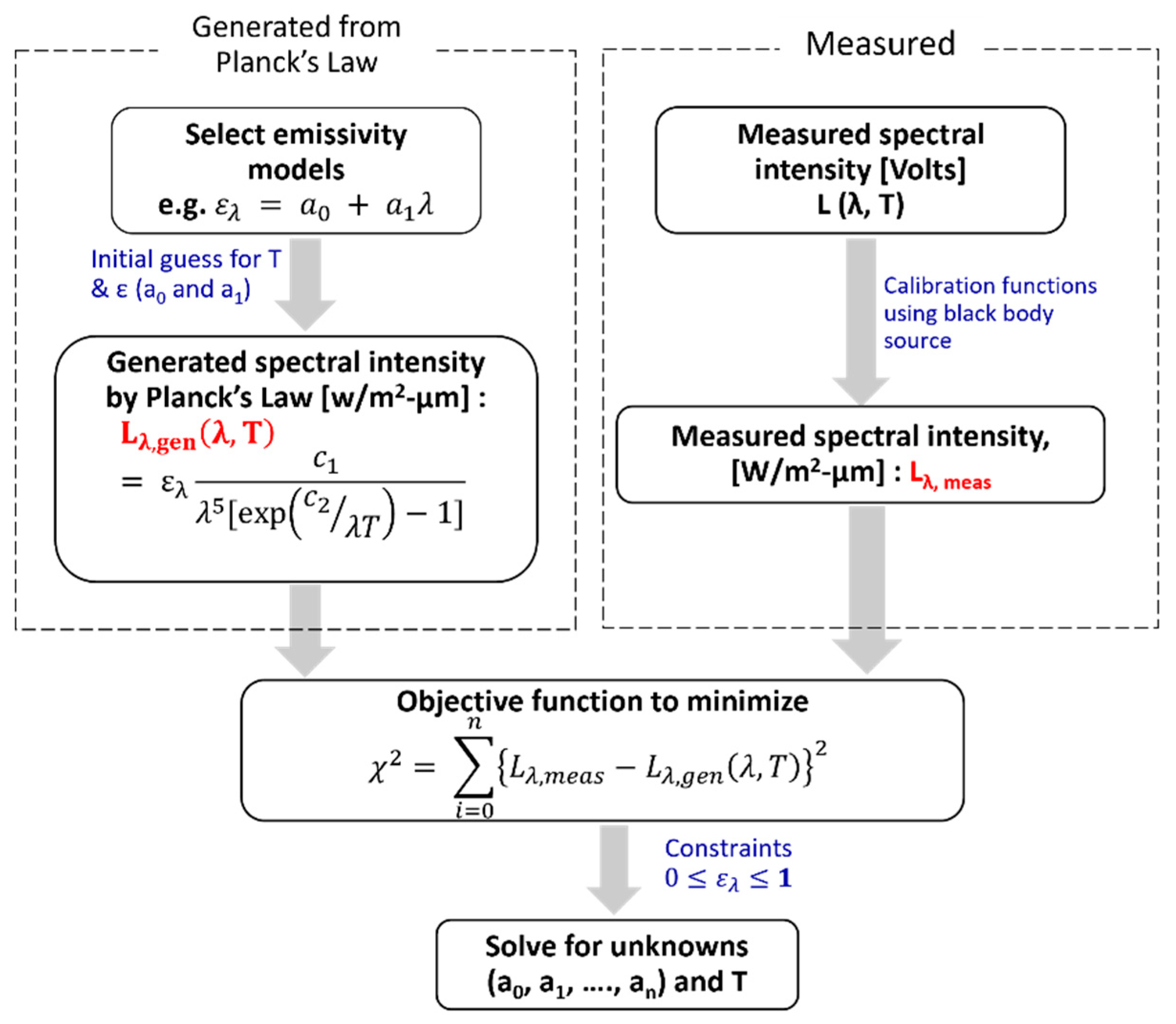
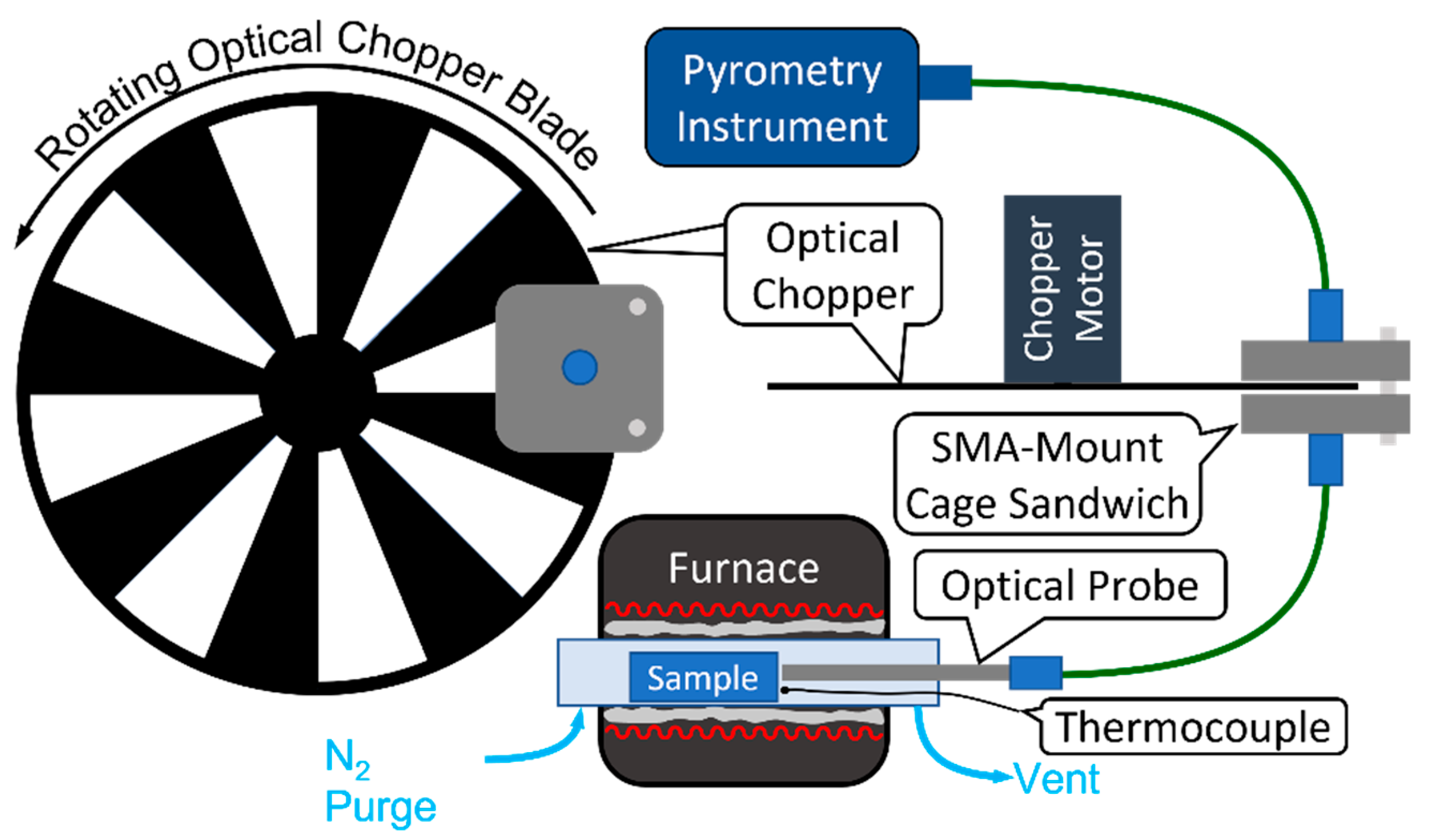
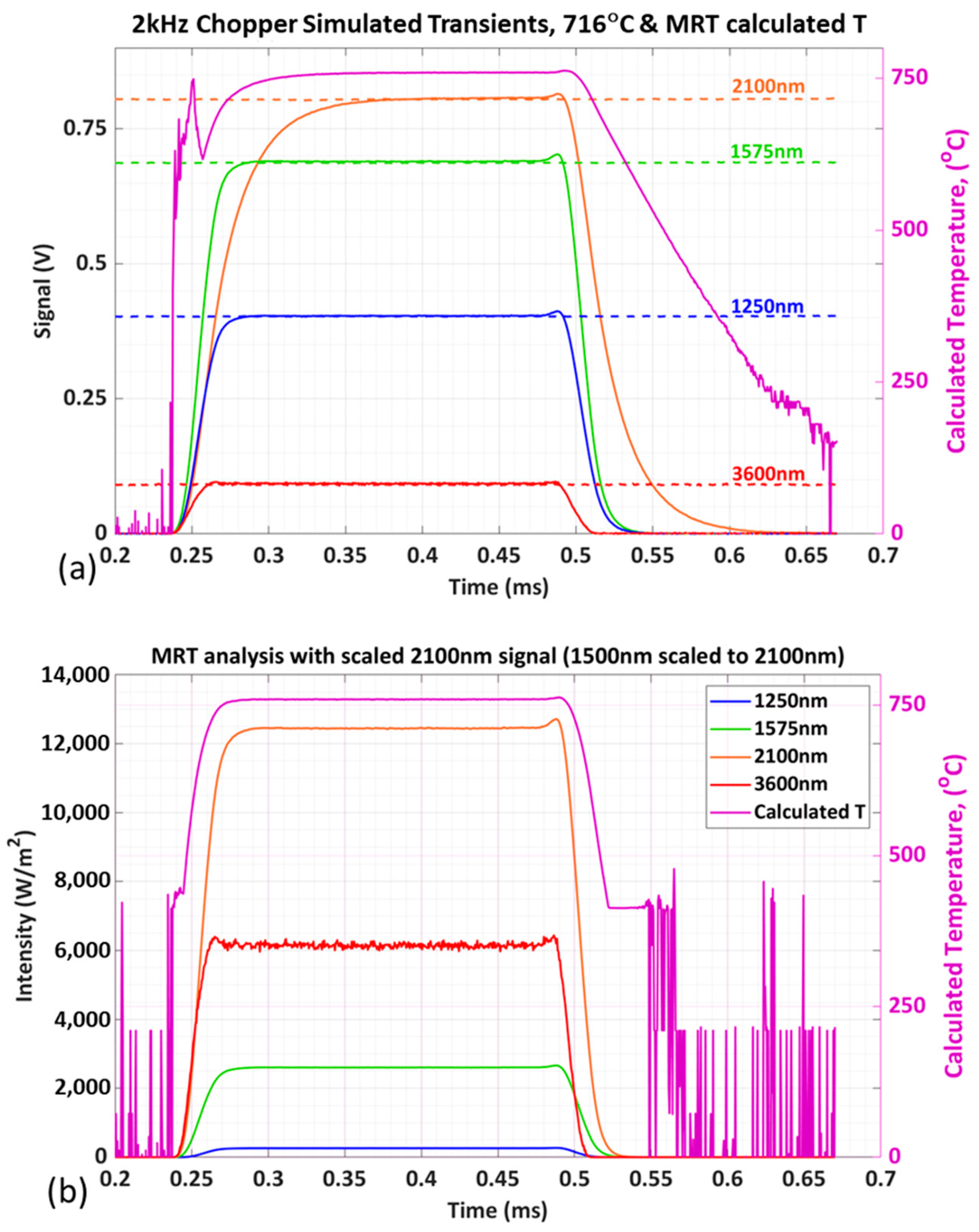
| Average SNR | MRT Fitting Method | Average % Error In MRT-Calculated Temperature | |||||||
|---|---|---|---|---|---|---|---|---|---|
| 600 °C | 650 °C | 700 °C | 750 °C | 800 °C | 850 °C | 900 °C | Average | ||
| 0–50 | LLS | 180 | 46.5 | 75.4 | 48.3 | - | - | - | 87.6 |
| NLLS | 66.6 | 14.1 | 6.9 | 75.1 | - | - | - | 40.7 | |
| 50–150 | LLS | 15.0 | 258 | 24.0 | 14.4 | 9.7 | 34.5 | 1.9 | 51.1 |
| NLLS | 0.56 | 11.8 | 25.0 | 10.6 | 2.6 | 5.7 | 4.7 | 8.7 | |
| 150–250 | LLS | - | - | 4.6 | 7.4 | 3.1 | - | 2.4 | 4.4 |
| NLLS | - | - | 0.9 | 9.2 | 4.6 | - | 3.0 | 4.4 | |
| 250–500 | LLS | - | 6.0 | - | - | 0.1 | 6.4 | 5.4 | 4.5 |
| NLLS | - | - | - | - | 4.9 | 5.4 | 5.1 | 5.1 | |
| >500 | LLS | - | - | - | 7.5 | - | 3.7 | 3.9 | 5.0 |
| NLLS | - | 1.2 | - | 5.8 | - | 5.7 | 5.0 | 4.4 | |
| Average SNR | n | Average % Error In MRT-Calculated Temperature | |||||||
|---|---|---|---|---|---|---|---|---|---|
| 600 °C | 650 °C | 700 °C | 750 °C | 800 °C | 850 °C | 900 °C | Average | ||
| 0–50 | 4 | 66.6 | 14.1 | 6.9 | 75.1 | - | - | - | 40.7 |
| 7 | 10.6 | 14.5 | 21.9 | 72.5 | 31.3 | - | - | 30.2 | |
| 50–150 | 4 | 0.6 | 11.8 | 25.0 | 10.6 | 2.6 | 5.7 | 4.7 | 8.7 |
| 7 | 0.8 | 3.8 | 30.7 | 7.9 | 4.8 | 4.4 | 9.6 | 8.9 | |
| 150–250 | 4 | - | - | - | 9.2 | 4.6 | - | 3.0 | 5.6 |
| 7 | - | - | - | 4.3 | 4.6 | - | 4.8 | 4.6 | |
| 250–500 | 4 | - | - | 0.9 | - | 4.9 | 5.4 | 5.1 | 4.1 |
| 7 | - | 2.2 | 5.0 | 5.8 | 3.8 | 5.7 | 5.4 | 4.6 | |
| >500 | 4 | - | 1.2 | - | 5.8 | - | 5.7 | 5.0 | 4.4 |
| 7 | - | - | - | - | - | 5.8 | 5.0 | 5.4 | |
| Analysis T (°C): | 610 | 714 | 819 | 911 | Avg. | |
|---|---|---|---|---|---|---|
| Error % in Calculated T | (Narrow λ region) Selected λ: 1.5, 1.6, 1.7, 1.8 um | 1.37 | 1.29 | 1.19 | 1.12 | 1.24 |
| (Broader λ region) Selected λ: 1.0, 1.4, 1.8, 2.0 um | 0.34 | 0.21 | 0.14 | 0.09 | 0.20 | |
| Guess # | Initial Guess T (C) | Initial Guess T (K) | MRT Calculated T (C) | SSE | Error in MRT Calculated T (%) |
|---|---|---|---|---|---|
| 1 | 500 | 773.2 | 910.5 | 0.039 | −0.09 |
| 2 | 550 | 823.2 | 910.5 | 0.040 | −0.09 |
| 3 | 600 | 873.2 | 910.5 | 0.031 | −0.09 |
| 4 | 650 | 923.2 | 910.5 | 0.036 | −0.09 |
| 5 | 700 | 973.2 | 910.5 | 0.036 | −0.09 |
| 6 | 750 | 1023.2 | 979.1 | 1.803 | 7.44 |
| 7 | 800 | 1073.2 | 979.3 | 1.779 | 7.46 |
| 8 | 850 | 1123.2 | 979.3 | 1.781 | 7.46 |
| 9 | 900 | 1173.2 | 979.3 | 1.781 | 7.46 |
| 10 | 950 | 1223.2 | 979.2 | 1.783 | 7.46 |
| 11 | 1000 | 1273.2 | 979.4 | 1.776 | 7.47 |
| 12 | 1050 | 1323.2 | 979.1 | 1.799 | 7.44 |
| 13 | 1100 | 1373.2 | 979.3 | 1.776 | 7.47 |
| 14 | 1150 | 1423.2 | 910.8 | 0.001 | −0.06 |
| 15 | 1200 | 1473.2 | 979.4 | 1.776 | 7.47 |
| 16 | 1250 | 1523.2 | 910.5 | 0.036 | −0.09 |
| 17 | 1300 | 1573.2 | 979.4 | 1.776 | 7.47 |
| 18 | 1350 | 1623.2 | 979.2 | 1.786 | 7.45 |
| 19 | 1400 | 1673.2 | 979.4 | 1.776 | 7.47 |
| True-T (°C) | 400 | 448 | 501 | 553 | 601 | 698 | 802 |
| MRT-T (°C) | 394 | 449 | 506 | 565 | 616 | 715 | 819 |
| % Error | 1.5 | 0.2 | 1.1 | 2.2 | 1.6 | 2.4 | 2.3 |
| Accuracy (%) | 98.5 | 99.8 | 98.9 | 97.8 | 98.4 | 97.6 | 97.7 |
| 2-Sigma Precision (%) | 99.72 | 99.84 | 99.92 | 99.96 | 99.97 | 99.99 | 99.96 |
| SNR(Average) | 63 | 137 | 265 | 488 | 815 | 1858 | 2492 |
Disclaimer/Publisher’s Note: The statements, opinions and data contained in all publications are solely those of the individual author(s) and contributor(s) and not of MDPI and/or the editor(s). MDPI and/or the editor(s) disclaim responsibility for any injury to people or property resulting from any ideas, methods, instructions or products referred to in the content. |
© 2022 by the authors. Licensee MDPI, Basel, Switzerland. This article is an open access article distributed under the terms and conditions of the Creative Commons Attribution (CC BY) license (https://creativecommons.org/licenses/by/4.0/).
Share and Cite
Neupane, S.; Jatana, G.S.; Lutz, T.P.; Partridge, W.P. Development of A Multi-Spectral Pyrometry Sensor for High-Speed Transient Surface-Temperature Measurements in Combustion-Relevant Harsh Environments. Sensors 2023, 23, 105. https://doi.org/10.3390/s23010105
Neupane S, Jatana GS, Lutz TP, Partridge WP. Development of A Multi-Spectral Pyrometry Sensor for High-Speed Transient Surface-Temperature Measurements in Combustion-Relevant Harsh Environments. Sensors. 2023; 23(1):105. https://doi.org/10.3390/s23010105
Chicago/Turabian StyleNeupane, Sneha, Gurneesh Singh Jatana, Timothy P. Lutz, and William P. Partridge. 2023. "Development of A Multi-Spectral Pyrometry Sensor for High-Speed Transient Surface-Temperature Measurements in Combustion-Relevant Harsh Environments" Sensors 23, no. 1: 105. https://doi.org/10.3390/s23010105
APA StyleNeupane, S., Jatana, G. S., Lutz, T. P., & Partridge, W. P. (2023). Development of A Multi-Spectral Pyrometry Sensor for High-Speed Transient Surface-Temperature Measurements in Combustion-Relevant Harsh Environments. Sensors, 23(1), 105. https://doi.org/10.3390/s23010105






